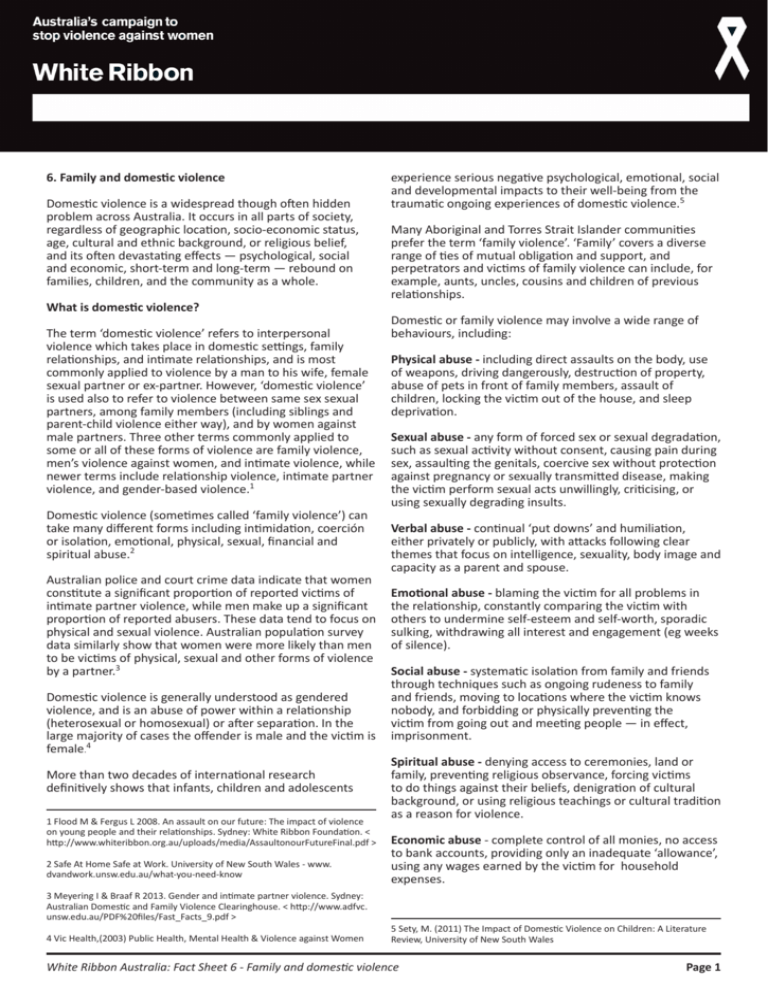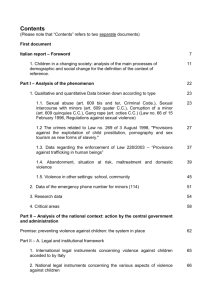
6. Family and domestic violence
Domestic violence is a widespread though often hidden
problem across Australia. It occurs in all parts of society,
regardless of geographic location, socio-economic status,
age, cultural and ethnic background, or religious belief,
and its often devastating effects — psychological, social
and economic, short-term and long-term — rebound on
families, children, and the community as a whole.
What is domestic violence?
The term ‘domestic violence’ refers to interpersonal
violence which takes place in domestic settings, family
relationships, and intimate relationships, and is most
commonly applied to violence by a man to his wife, female
sexual partner or ex-partner. However, ‘domestic violence’
is used also to refer to violence between same sex sexual
partners, among family members (including siblings and
parent-child violence either way), and by women against
male partners. Three other terms commonly applied to
some or all of these forms of violence are family violence,
men’s violence against women, and intimate violence, while
newer terms include relationship violence, intimate partner
violence, and gender-based violence.1
Domestic violence (sometimes called ‘family violence’) can
take many different forms including intimidation, coerción
or isolation, emotional, physical, sexual, financial and
spiritual abuse.2
Australian police and court crime data indicate that women
constitute a significant proportion of reported victims of
intimate partner violence, while men make up a significant
proportion of reported abusers. These data tend to focus on
physical and sexual violence. Australian population survey
data similarly show that women were more likely than men
to be victims of physical, sexual and other forms of violence
by a partner.3
Domestic violence is generally understood as gendered
violence, and is an abuse of power within a relationship
(heterosexual or homosexual) or after separation. In the
large majority of cases the offender is male and the victim is
female.4
More than two decades of international research
definitively shows that infants, children and adolescents
1 Flood M & Fergus L 2008. An assault on our future: The impact of violence
on young people and their relationships. Sydney: White Ribbon Foundation. <
http://www.whiteribbon.org.au/uploads/media/AssaultonourFutureFinal.pdf >
2 Safe At Home Safe at Work. University of New South Wales - www.
dvandwork.unsw.edu.au/what-you-need-know
3 Meyering I & Braaf R 2013. Gender and intimate partner violence. Sydney:
Australian Domestic and Family Violence Clearinghouse. < http://www.adfvc.
unsw.edu.au/PDF%20files/Fast_Facts_9.pdf >
4 Vic Health,(2003) Public Health, Mental Health & Violence against Women
experience serious negative psychological, emotional, social
and developmental impacts to their well-being from the
traumatic ongoing experiences of domestic violence.5
Many Aboriginal and Torres Strait Islander communities
prefer the term ‘family violence’. ‘Family’ covers a diverse
range of ties of mutual obligation and support, and
perpetrators and victims of family violence can include, for
example, aunts, uncles, cousins and children of previous
relationships.
Domestic or family violence may involve a wide range of
behaviours, including:
Physical abuse - including direct assaults on the body, use
of weapons, driving dangerously, destruction of property,
abuse of pets in front of family members, assault of
children, locking the victim out of the house, and sleep
deprivation.
Sexual abuse - any form of forced sex or sexual degradation,
such as sexual activity without consent, causing pain during
sex, assaulting the genitals, coercive sex without protection
against pregnancy or sexually transmitted disease, making
the victim perform sexual acts unwillingly, criticising, or
using sexually degrading insults.
Verbal abuse - continual ‘put downs’ and humiliation,
either privately or publicly, with attacks following clear
themes that focus on intelligence, sexuality, body image and
capacity as a parent and spouse.
Emotional abuse - blaming the victim for all problems in
the relationship, constantly comparing the victim with
others to undermine self-esteem and self-worth, sporadic
sulking, withdrawing all interest and engagement (eg weeks
of silence).
Social abuse - systematic isolation from family and friends
through techniques such as ongoing rudeness to family
and friends, moving to locations where the victim knows
nobody, and forbidding or physically preventing the
victim from going out and meeting people — in effect,
imprisonment.
Spiritual abuse - denying access to ceremonies, land or
family, preventing religious observance, forcing victims
to do things against their beliefs, denigration of cultural
background, or using religious teachings or cultural tradition
as a reason for violence.
Economic abuse - complete control of all monies, no access
to bank accounts, providing only an inadequate ‘allowance’,
using any wages earned by the victim for household
expenses.
5 Sety, M. (2011) The Impact of Domestic Violence on Children: A Literature
Review, University of New South Wales
White Ribbon Australia: Fact Sheet 6 - Family and domestic violence Page 1
Healthy or abusive relationships...
Characteristics of SAFE AND HEALTHY Relationships Characteristics of ABUSIVE Relationships
Partnerships Domination
Joint decision making Abuser decides
Shared responsibilities Servant/master mentality
Economic Equality Economic Control
Freedom to decide issues of work, school and money Deny job freedom
Withhold money
Emotional Honesty Physical Abuse: hit, choke, kick, pinch, pull hair, poke,
Feel safe to admit and share fears and insecurities twist arms, trip, bite, restrain, use weapons
Sexual Respect Emotional Manipulation
Accept that “no” means no Use jealousy, passion, stress and frustration to justify actions
Physical Safety Sexual Abuse
Respect partner’s physical space Force partner to do things against her/his will
Express self non-violently
Respect Intimidation
Respect right to differing feelings, friends and activities Charming in public, menacing in private
Support partner’s goals Destroy property or pets
Make light of abuse: “You’re too sensitive”
Support and trust Control
Listen and understand Name calling and mind games
Value partner’s opinion Isolate partner from friends and loved ones
White Ribbon Australia: Fact Sheet 6 - Family and domestic violence Page 2
Power and Control Cycle
©Pence and Paymar (1986).
Reference: Pence, E. & Paymar, M. (1986).
Power and Control Tactics of Men who Batter.
Duluth, MN: Minnesota Program Development, Inc
Cycle of Violence
Adapted from Lenore Walker, The Battered Woman (1986)
Reference: Walker, L. E. (1979). The Battered Woman. New York: Harper & Row.
These graphics were reproduced from The Hurt Project: DVD Training Guide. Perth,
Western Australia, with the kind permission of the author of the DVD Training Guide,
Nicole Leggett, Project Officer, WCDFVS.
Reference: Women’s Council for Domestic and Family Violence Services, Western
Australia. (2008)
White Ribbon Australia: Fact Sheet 6 - Family and domestic violence Page 3










